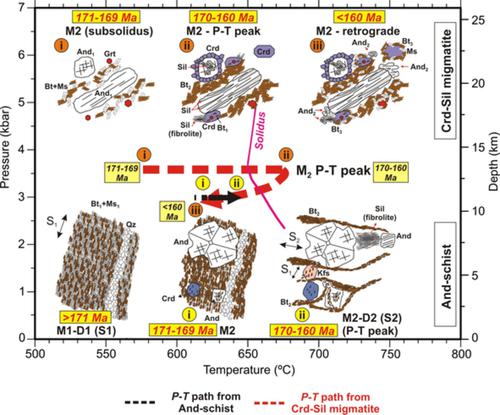当前位置:
X-MOL 学术
›
Geolog. J.
›
论文详情
Our official English website, www.x-mol.net, welcomes your
feedback! (Note: you will need to create a separate account there.)
P–T–t path of the Boroujerd Complex, north-west Sanandaj–Sirjan Zone, western Iran: Insights from phase equilibrium modelling and thermobarometry
Geological Journal ( IF 1.4 ) Pub Date : 2021-04-04 , DOI: 10.1002/gj.4135 Somayeh Rahmani Javanmard 1 , Sebastián O. Verdecchia 2 , Chris Yakymchuk 3 , Maarten A. T. M. Broekmans 4
Geological Journal ( IF 1.4 ) Pub Date : 2021-04-04 , DOI: 10.1002/gj.4135 Somayeh Rahmani Javanmard 1 , Sebastián O. Verdecchia 2 , Chris Yakymchuk 3 , Maarten A. T. M. Broekmans 4
Affiliation

|
Variations in the pressures and temperatures of metamorphism reflect the complexity of collisional orogenic systems. In the north-west Sanandaj–Sirjan Zone of western Iran, migmatites in the Boroujerd area record earlier dynamothermal metamorphism followed by the development of a contact metamorphic aureole induced by the Jurassic Boroujerd Batholith. Integrated micro-textural observations, mineral compositions, and the results of phase equilibrium modelling indicate that peak metamorphic temperatures reached 640–660°C in andalusite schists and ~700°C in cordierite–sillimanite migmatites. The pressure does not exceed 3.5 kbar, implying a maximum depth of ~13 km. A hairpin clockwise P–T path in the Boroujerd region was inferred from mineral relations (e.g., replacement of andalusite1 by sillimanite in the migmatites in the heating stage, which was followed by a retrograde episode with growth of andalusite2) and P–T pseudosections. Metamorphism of the Boroujerd area was coeval with voluminous intermediate–mafic magmatism, which provided the heat necessary for partial melting. This study demonstrates that metamorphic sequences of the north-west Sanandaj–Sirjan Zone developed under similar metamorphic conditions in the Lower to Middle Jurassic and record an extensional back-arc setting related to the subduction of Neo-Tethys.
中文翻译:

伊朗西部 Sanandaj-Sirjan 区西北部 Boroujerd 复合体的 P-T-t 路径:相平衡建模和热压测量的见解
变质作用的压力和温度变化反映了碰撞造山系统的复杂性。在伊朗西部的西北 Sanandaj-Sirjan 带,Boroujerd 地区的混合岩记录了较早的热力变质作用,随后是由侏罗纪 Boroujerd 基岩诱发的接触变质光环的发展。综合微观结构观察、矿物组成和相平衡模型的结果表明,红柱石片岩的峰值变质温度达到 640-660°C,堇青石-硅线石混合岩的峰值变质温度达到 700°C。压力不超过 3.5 kbar,意味着最大深度约为 13 公里。从矿物关系推断出 Boroujerd 地区的发夹顺时针P-T路径(例如,红柱石1加热阶段混合岩中的硅线石,随后是逆行事件,红柱石2 ) 和P-T假断面的生长。Boroujerd 地区的变质作用与大量的中基性岩浆作用同时发生,为部分熔融提供了必要的热量。这项研究表明,在下侏罗统到中侏罗统类似的变质条件下,西北部 Sanandaj-Sirjan 带的变质层序发育,并记录了与新特提斯俯冲相关的伸展弧后环境。
更新日期:2021-06-02
中文翻译:

伊朗西部 Sanandaj-Sirjan 区西北部 Boroujerd 复合体的 P-T-t 路径:相平衡建模和热压测量的见解
变质作用的压力和温度变化反映了碰撞造山系统的复杂性。在伊朗西部的西北 Sanandaj-Sirjan 带,Boroujerd 地区的混合岩记录了较早的热力变质作用,随后是由侏罗纪 Boroujerd 基岩诱发的接触变质光环的发展。综合微观结构观察、矿物组成和相平衡模型的结果表明,红柱石片岩的峰值变质温度达到 640-660°C,堇青石-硅线石混合岩的峰值变质温度达到 700°C。压力不超过 3.5 kbar,意味着最大深度约为 13 公里。从矿物关系推断出 Boroujerd 地区的发夹顺时针P-T路径(例如,红柱石1加热阶段混合岩中的硅线石,随后是逆行事件,红柱石2 ) 和P-T假断面的生长。Boroujerd 地区的变质作用与大量的中基性岩浆作用同时发生,为部分熔融提供了必要的热量。这项研究表明,在下侏罗统到中侏罗统类似的变质条件下,西北部 Sanandaj-Sirjan 带的变质层序发育,并记录了与新特提斯俯冲相关的伸展弧后环境。











































 京公网安备 11010802027423号
京公网安备 11010802027423号